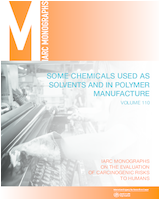NCBI Bookshelf. A service of the National Library of Medicine, National Institutes of Health.
IARC Working Group on the Evaluation of Carcinogenic Risks to Humans. Some Chemicals Used as Solvents and in Polymer Manufacture. Lyon (FR): International Agency for Research on Cancer; 2017. (IARC Monographs on the Evaluation of Carcinogenic Risks to Humans, No. 110.)
2.1. Cohort studies
See Table 2.1 for study details
Table 2.1
Cohort studies of cancer and occupational exposure to tetrafluoroethylene.
Only one cohort study analysing cancer risk in relation to exposure to tetrafluoroethylene was available to the Working Group. Consonni et al. (2013) studied mortality from cancer and from selected non-malignant diseases in a cohort including workers in six polytetrafluoroethylene-production sites in Europe (Germany, the Netherlands, Italy, England) and the USA (New Jersey, West Virginia) from 1950 to 2002. Production of polytetrafluoroethylene involves the use of ammonium perfluorooctanoate, exposure to which was also analysed. Follow-up was from start of production between 1950 and 1970, until 2008. Of the 5879 men identified, 4773 who were potentially exposed were included in the analysis.
Semiquantitative estimates of individual exposure to tetrafluoroethylene and ammonium perfluorooctanoate were reconstructed based on a specifically developed job-exposure matrix (Sleeuwenhoek & Cherrie, 2012). Standardized mortality ratios (SMRs) were calculated using national mortality rates as comparison. Plant-specific results were not presented.
In the overall analysis, elevated risks were seen for all cancer sites of a-priori interest: liver, 1.27 (95% CI, 0.55–2.51); kidney, 1.44 (95% CI, 0.69–2.65); and leukaemia, 1.48 (95% CI, 0.77–2.59). No significant trends in risk with increasing exposure were observed with cumulative exposure to tetrafluoroethylene, or with duration of exposure or time since exposure for any of the cancer sites of interest (Table 2.1). A significant downward trend in the risk of cancer of the lung was observed with increasing exposure duration, but not with other exposure metrics. Additional analyses using regional comparison rates did not materially change risk estimates. Eighty-eight percent of workers were exposed to ammonium perfluorooctanoate as well as to tetrafluoroethylene. Analysis of patterns of mortality with ammonium perfluorooctanoate or tetrafluoroethylene as the exposure of interest gave very similar results.
[The results suggested an elevated risk of cancer of the liver and kidney, and leukaemia. Direct control for possible non-occupational confounders was not possible; however, based on analysis of mortality patterns in the cohort and general knowledge of exposures in the included plants, the Working Group judged that major confounding by alcohol, tobacco, hepatitis B virus, or vinyl chloride monomer was unlikely. The power of the study was, however, not sufficient to support a causal association with tetrafluoroethylene. The Working Group characterized this as a well-conducted study with thorough exposure assessment, which with a longer follow-up would be expected to have more deaths and hence more statistical power to detect any possible associations.]
2.2. Case–control studies
No case–control studies on cancer risk and exposure to tetrafluoroethylene were available to the Working Group.
- Cancer in Humans - Some Chemicals Used as Solvents and in Polymer ManufactureCancer in Humans - Some Chemicals Used as Solvents and in Polymer Manufacture
Your browsing activity is empty.
Activity recording is turned off.
See more...
